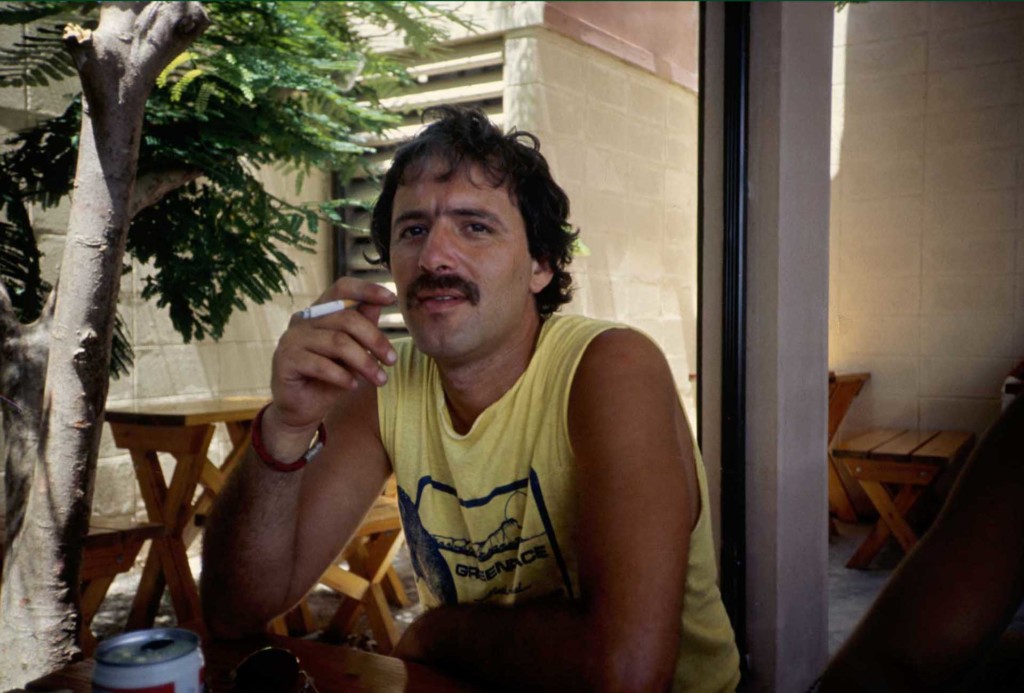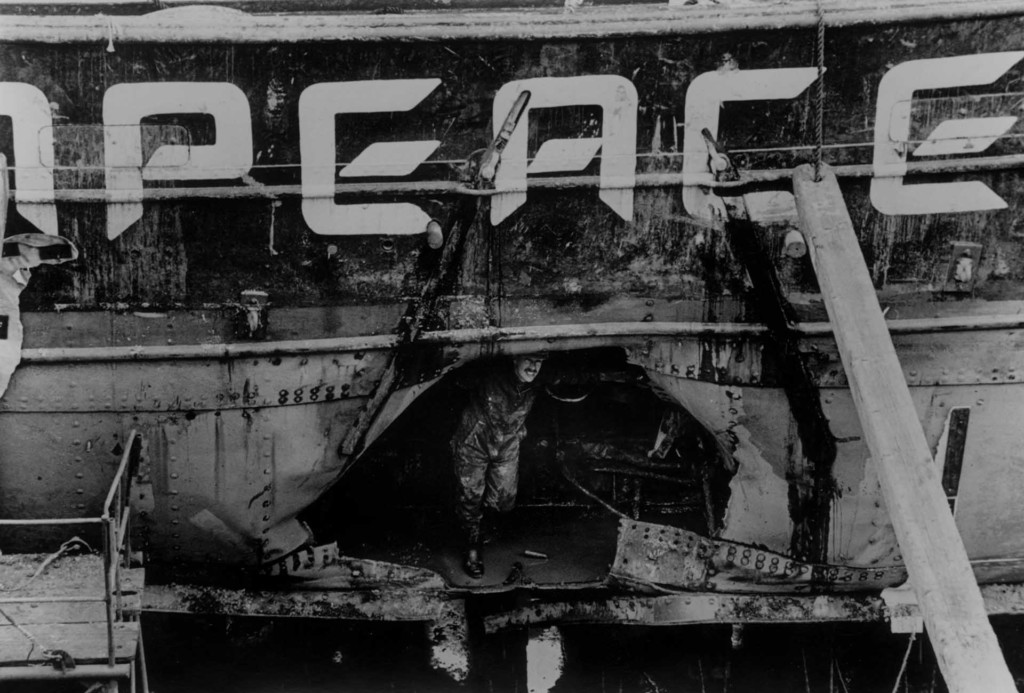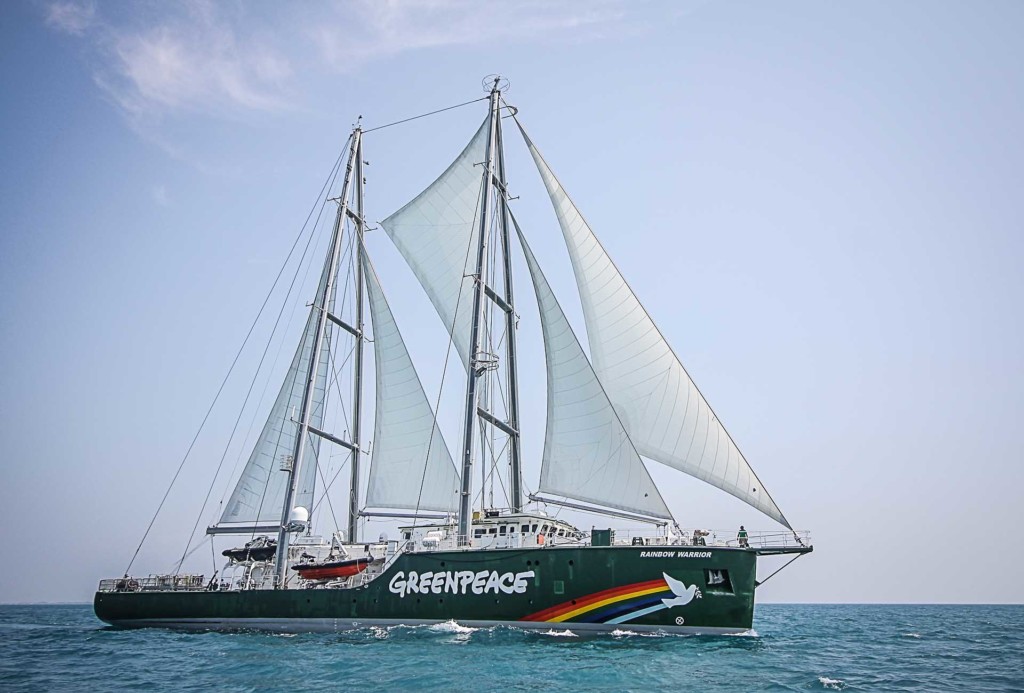You can’t sink a Rainbow.
In 1985, French secret service agents planted two bombs and sank the Greenpeace ship the Rainbow Warrior. One crew member was killed. It was an instance when a government chose to respond to peaceful protest with deadly force. But peaceful protest has prevailed.
The Greenpeace ship Rainbow Warrior in Auckland Harbour, New Zealand, after being sunk by limpet mines planted by the French secret service.
10 July 1985. The Greenpeace ship the Rainbow Warrior is moored in Auckland, New Zealand – ready to confront French nuclear testing in the Moruroa Atoll.
It’s close to midnight. The captain, Pete Willcox, and many other crew members are already asleep. A few others, including the photographer Fernando Pereira, are still chatting around the mess-room table, sharing between them the last two bottles of beer.
Suddenly, the lights go out. There’s the sharp crack of breaking glass. Then, a sudden roar of water. The crew’s first thought: We’ve been hit, possibly by a tug.
Then, there’s a second explosion.
Those already on deck scramble up the ladder or leap to safety on the wharf. Within minutes, they see the ship’s steel masts tilt towards them…
The tragic death of a crew member
“I stood there looking at the boat with all of these bubbles coming out of it,” captain Pete Willcox would later recall. “That’s when Davey [Edwards] said Fernando is down there. I remember arguing with him, saying no, Fernando has gone to town, that’s what he always did. No he said. Fernando is down there.”

The Portugal-born Greenpeace photographer Fernando Pereira had joined the crew of the Rainbow Warrior to document the French nuclear testing and bring his photographs to the world.
He was caught in a rush of water that night, and drowned. He had just celebrated his 35th birthday.
A state-sanctioned bombing – shrewdly planned and executed
The Rainbow Warrior wasn’t hit by a tug, of course. In an attempt to “neutralise” the ship ahead of its planned protest, French secret service agents in diving gear had attached two packets of plastic-wrapped explosives to it, one by the propeller, one to the outer wall of the engine room.
Initially, the French government denied all knowledge of the operation, but it became soon obvious that they were involved. Eventually, prime minister Laurent Fabius appeared on television and told a shocked public: “Agents of the DGSE (Secret Service) sank this boat. They acted on orders.”

A gaping hole can be seen in the side of the Rainbow Warrior following the bombing by French secret service agents.
First they denied, then they disappeared
Only two agents ever stood trial. Dominique Prieur and Alain Mafart, who had posed as Swiss tourists, pleaded guilty to charges of manslaughter and wilful damage, attracting sentences of 10 and 7 years. A UN negotiated settlement meant that they were transferred to Hao atoll, a French military base in French Polynesia.
They were both released within less than two years.
The spy who infiltrated the Greenpeace New Zealand office ahead of the bombing, Christine Cabon, evaded arrest in Israel. She hasn’t been seen since. The whereabouts of the combat frogman with the alias Jean-Michel Berthelot – one of the two divers believed to have planted the bombs – are unknown.
Most of those involved in what happened that night in an Auckland harbour have simply disappeared.
You can’t sink a Rainbow
The Rainbow Warrior was named after a North American Cree Indian prophecy: “When the world is sick and dying, the people will rise up like Warriors of the Rainbow…”
On its bow she proudly carried a dove of peace carrying an olive branch – never leaving any doubt about her non-violent mission. All around her hull, there were the striking colours of the rainbow.
After the bombing, the ship was given a resting place at Matauri Bay, in New Zealand’s Cavalli Islands, where it has become a living reef, attracting marine life and recreational divers.
Greenpeace replaced her with a new vessel, and for 22 years, the second Rainbow Warrior has campaigned for a green and peaceful future. In 2011 the new Rainbow Warrior, the world’s first purpose-built environmental campaigning ship, readied herself to carry on the original Rainbow Warrior’s spirit. It’s a spirit that will always live on.

